22 August 2025
Following A level, T level and Level 3 vocational qualification results day last week (covered by us here), it’s now the turn of GCSEs and other Level 2 qualifications.
The key points below focus on the GSCEs results for 16-year-olds at the ‘standard pass’ level of grade 4 (old grading C pass) and above (represents 70.5% of the exam passes), rather than grade 7 and above (which reflects only 23%). A point made previously on how the commentary on A levels focusses on the less representative A* and above grades rather than the average ‘standard’ C and above grade. The latter is better.
These figures below are just for England.
In summary:
- Boys have made small progress since 2015 in the percentage pass rates (+1.5 percentage points), and the gender attainment gap, overall, has closed. However, it remains in place (+6.1 percentage points) and is as much due to a fall in performance of girls than it is to an improvement from boys.
- Boys continually to be considerably behind girls in English (10.4 percentage points) but are now ahead of girls in Maths (-1.7 percentage points) – a change that started in 2023.
- There has been a little progress in boys’ English pass rates (+0.4 percentage points) since 2015 but a better increase in maths (+3.2 percentage points).
In looking at a range of broader outcomes, further analysis has been produced (primarily from data sources used in the CPRMB May 2025 report ‘Missing Men’ on unemployment, suicide, pay, youth prison population and exclusions. The overall picture is not positive.
- Overall grade 4 and above percentage passes (16-year-old)
The broad picture shows that boys’ pass rates have improved over the last ten years (66% in 2015 and 67.5% in 2025) but it is not huge progress. The figures are ticking up coming out of the pandemic period.
Figure 1: C/4 grades – percentage passes (16-year-olds)
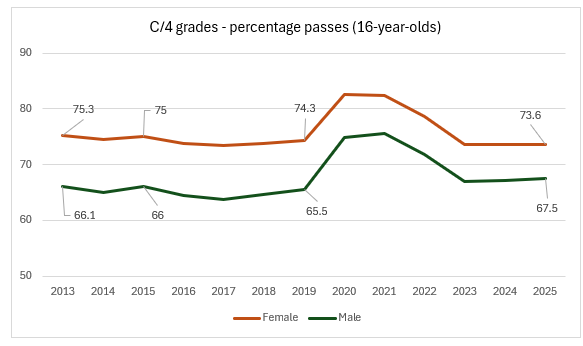
The gender attainment gap has closed from 9 percentage points in 2015 to 6.1 percentage points in 2025. However, there remains a gap. In overall numbers terms, girls received 128,180 more GCSE passes at grade 4 and above than boys.
The closing of the gender attainment gap is as much due to girls’ weakening performance than it is for boys’ improved performance.
Figure 2: C/4 gender attainment gap by percentage point (Female to Male)
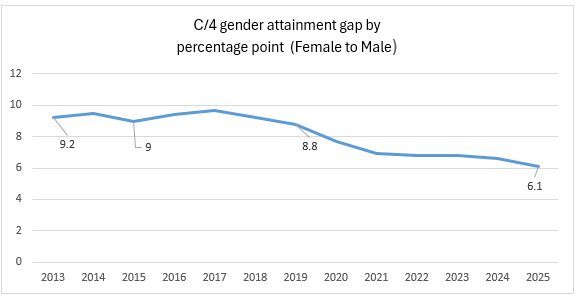
The Joint Council of Qualifications produced combined data for England, Wales and Northern Ireland. This showed that 19.4% of boys and 24.5% of girls achieved C/4 grades.
(B) Overall grade 4 and above English percentage passes (16-year-old)
The broad picture shows that boys’ pass rates have barely improved since 2015 (65.1% in 2015 and 65.5% in 2025) so there has been little progress.
Figure 3: C/4 grades – percentage passes English (16 year-olds)

The gender attainment gap has closed from 15.5 percentage points in 2015 to 10.4 percentage points in 2025. However, there remains a gap. In overall number terms, 16-year-old girls received 25,783 more GCSE grade 4 and above passes than boys.
Figure 4: Gender Attainment Gap (English) – percentage point (Female to Male)
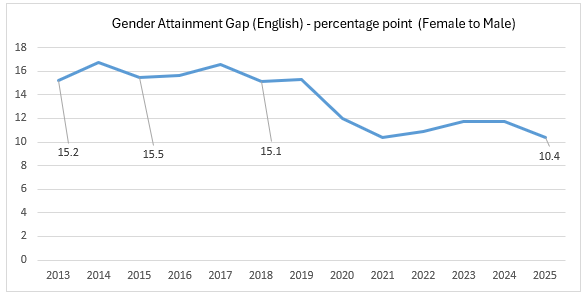
The Joint Council of Qualifications produced combined data for England, Wales and Northern Ireland. This showed that 54.4% of boys and 66.6% of girls achieved C/4 grades in English.
(C) Overall grade 4 and above Maths percentage passes (16-year-old)
The broad picture shows that boys’ pass rates have made positive progress in Maths since 2015 (72.7% in 2015 and 69.5% in 2025).
Figure 5: C/4 grades – percentage passes Maths (16-year-olds)
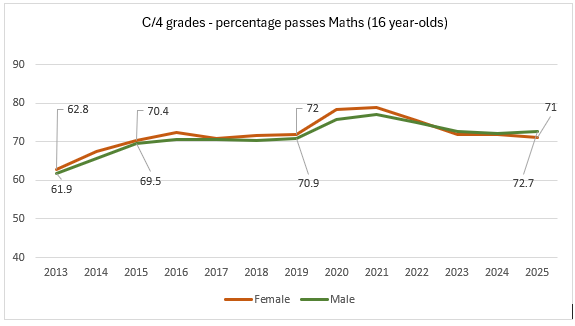
Since 2023, the gender attainment gap in Maths has flipped, with 16-year-old boys receiving a higher percentage of Grade 4 passes than their female peers. The gap is growing from +0.9 percentage points in 2015 in favour of girls, to now being -1.7 percentage points in favour of boys.
In overall number terms, 16-year-old boys received 12,631 more GCSE grade 4 and above Maths passes than girls.
Figure 6: Gender Attainment Gap (Maths) – percentage point (Female to Male)
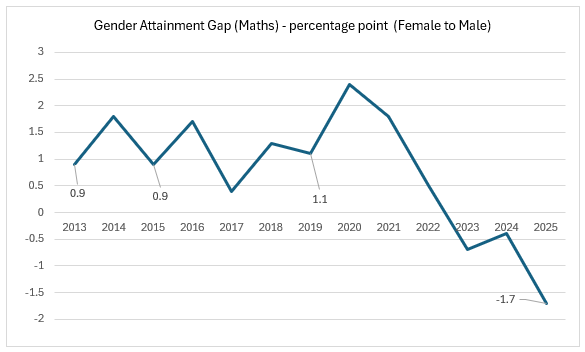
(D) Wider outcomes for boys and young men
As well as educational attainment, there are a wider range of additional outcomes for young men and boys – some of which may have been caused by a lack of attainment, especially around literacy. It is hard to succeed if you your literacy is not good enough to understand the curriculum.
- Not in Education, Employment and Training (NEET)
The latest NEET figures (16- to 24-year-olds) produced by the Office for National Statistics shows that for the UK in April to June 2025:
- 224,000 young men (16-24) are unemployed (Apr-Jun 2025) and, 273,000 economically inactive.
- 140,000 young women are unemployed and 310,000 economically inactive.
- Young men make up 62% of young people who are unemployed.
- Youth Custody
The population of the Children and Young People’s Secure Estate by sex in England and Wales shows that in June 2025, there were 480 young men and 15 young women in youth custody. The figures are for those under 18.
- Exclusions
The latest figures published by the Department for Education in July 2025 showed 7,695 boys (3,190 girls) in England were excluded from school in 2023/24 (figures published in July 25).
The rates per 100 pupils for males had fallen since 2006/07 (0.18 per 100) but are now back to that same rate (23/24). A point made by the CPRMB in its recent research snapshot on this issue.
- Teenage Suicides
The last published Office for National Statistics figures on suicide showed that in 2023, 149 teenage boys (15-19) died by suicide.
Article I wrote on LinkedIn: https://www.linkedin.com/pulse/policy-research-vacuum-teenage-male-suicides-mark-brooks-obe-yny5e/?trackingId=LbrrZ5oPRnmQ13qBqQoA%2FA%3D%3D
- Gender Pay Gap
The latest gender pay gap figures produced by the Office for National Statistics, shows that the gender pay gap is in favour of young women rather than young men for those aged 18-21.
Further analysis by the Centre for Social Justice based on the trend data, suggest that this gap favours young women up until they are 24, and then it switches over.